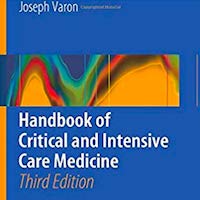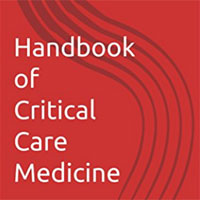Tag: therapy
RRT in the Critically Ill Child
Although renal replacement therapy (RRT) is widely used in critically ill children, there have been few comprehensive population-based studies of its use. This article describes renal replacement therapy use, and associated... read more
Ten False Beliefs in Neurocritical Care
1. Only neurointensivists should care about the brain. 2. Clinical examination of neurocritically ill patients is impossible. 3. We should no longer monitor ICP in traumatic brain injury (TBI). 4. The threshold to treat... read more
In ICUs, a Furry Friend to Comfort Patients
Amid the monitor alarms and life-and-death conversations on the intensive care unit, Tucker, a very mellow Labrador retriever, rolled onto his back at the nurses' station. Delighted staff surrounded the dog, cooing and scratching... read more
Does Respiratory Variation Of Inferior Vena Cava Diameter Predict Fluid Responsiveness In Spontaneously Ventilating Children With Sepsis
IVC collapsibility has poor test characteristics for predicting fluid responsiveness in spontaneously ventilating children with sepsis. Thirty-nine fluid boluses were recorded in 33 children, 28/39 (72%) of which met criteria... read more
Procalcitonin Testing to Guide Antibiotic Therapy in Acute Upper and Lower Respiratory Tract Infections
Is the use of procalcitonin for guiding antibiotic decisions in patients with acute upper and lower respiratory tract infections associated with improved clinical outcomes compared with usual care? Among patients with varying... read more
Too Much SALT on the ICU?
There has a been a little flutter of activity in the #FOAMed world this week about two trials published in the NEJM on the subject of balanced fluids in the care of critically ill patients, and also on admitted patients in... read more
Association Between Continuous Hyperosmolar Therapy and Survival in Patients with TBI
Intracranial hypertension (ICH) is a major cause of death after traumatic brain injury (TBI). Continuous hyperosmolar therapy (CHT) has been proposed for the treatment of ICH, but its effectiveness is controversial. We compared... read more
Haloperidol Prophylaxis in Critically Ill Patients with a High Risk for Delirium
The use of the delirium prevention protocol seems to result in improvement of several delirium outcome measures. Prophylactic treatment with low dose haloperidol in critically ill patients with a high risk of delirium likely... read more
Update of a Systematic Review of Autoresuscitation After Cardiac Arrest
Although case reports of autoresuscitation are hampered by variability in observation and monitoring techniques, autoresuscitation has now been reported in adults and children, and there appears to be a distinction in timing... read more
Decision-making on withholding or withdrawing life-support in the ICU
Many critically ill patients who die will do so after a decision has been made to withhold/withdraw life-sustaining therapy. Our objective was to document the characteristics of intensive care unit (ICU) patients with a decision... read more
Noninvasive Ventilation in Hypercapnic COPD
Recently, Murphy and colleagues reported findings from a clinical trial designed to evaluate the effect of home noninvasive ventilation (NIV) with oxygen on time to readmission or death in patients with persistent hypercapnia... read more
R.E.B.E.L. EM – Fluid Responsiveness and the Six Guiding Principles of Fluid Resuscitation
Fluid resuscitation is a crucial aspect of emergency and critical care. Since the advent of the concept of early goal-directed therapy, we have placed a huge emphasis on aggressive fluid resuscitation in patients with severe... read more
Music as Therapy in the ICU
Music has been shown to reduce respiratory, cardiac and blood pressure frequencies in response to the reduction of stress hormones. In a randomized clinical trial, it was shown to reduce anxiety and sedation doses/intervals... read more
Adjuvant Therapies in Critical Care: Music Therapy
Emerging from the perioperative and oncology fields, music therapy (MT) and patient-directed music interventions (PDMI) have recently garnered interest in the area of critical care. The main goal of these music-based adjuvant... read more
Oral Versus Intravenous Antibiotics for the Treatment Of Bone and Joint Infection
Oral antibiotic therapy is non-inferior to IV therapy when used during the first six weeks in the treatment for bone and joint infection, as assessed by definitive treatment failure within one year of randomisation. These... read more
Do We Need New Trials of Procalcitonin-Guided Antibiotic Therapy?
Using biomarkers as a guide to tailor the duration of antibiotic treatment in respiratory infections is an attractive hypothesis assessed in several studies. Recent work aiming to summarize the evidence assessed the effect... read more
Prompt Administration of Antibiotics and Fluids in the Treatment of Sepsis
We conclude that antibiotic therapy is highly time sensitive, and efforts should be made to deliver this critical therapy as early as possible in sepsis, perhaps extending into the first point of medical contact outside the... read more
Association of ICH Among Patients Taking Non–Vitamin K Antagonist vs Vitamin K Antagonist Oral Anticoagulants With In-Hospital Mortality
Among patients with ICH, prior use of NOACs or warfarin was associated with higher in-hospital mortality compared with no OACs. Prior use of NOACs, compared with prior use of warfarin, was associated with lower risk of in-hospital... read more
Advanced Hemodynamic and Cardiopulmonary Ultrasound for Critically Ill Patients
Focused echocardiography, advanced hemodynamic, and cardiopulmonary point-of-care ultrasound studies provide time-sensitive evaluation of critically ill patients, guiding and facilitating earlier implementation of life-preserving... read more
The Case of the Relative Insufficiency
When it comes to the efficacy of glucocorticoid therapy for the treatment of septic shock, we have existed in a state of ambiguity, torn between the results of two contradictory RCTs. The first, the Annane et al trial published... read more
Adjunctive Glucocorticoid Therapy in Patients with Septic Shock
Among patients with septic shock undergoing mechanical ventilation, a continuous infusion of hydrocortisone did not result in lower 90-day mortality than placebo. We randomly assigned patients with septic shock who were undergoing... read more
ECMO for Severe Middle East Respiratory Syndrome Coronavirus
Extracorporeal membrane oxygenation (ECMO) use, as a rescue therapy, was associated with lower mortality in MERS patients with refractory hypoxemia. The results of this, largest to date, support the use of ECMO as a rescue... read more









